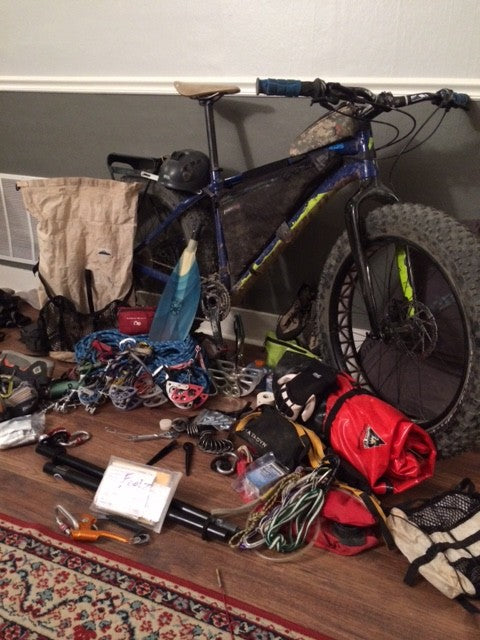The History of Going Light
Stripped Down: The Philosophy of Going Light

Now & Then
Major changes have taken place in the world of backcountry travel in the last half century. Adventurers now rock climb 3,500-foot walls in record speeds and hike thousands of miles carrying backpacks that weigh less than a small dog. Pioneers have questioned tradition and tested boundaries, transforming their adventure sports and the gear they use for those sports.
When Warren Harding, Wayne Merry and George Whitmore first climbed El Capitan, Yosemite National Park, they spent 47 days on the route using “siege tactics.” They hammered in hundreds of pitons and fixed thousands of feet or rope. Nowadays, people regularly climb their famous route, The Nose, in less than 24 hours. Alex Honnold and Hans Florine climbed it in just over two hours in 2012!
Likewise people have been trekking and camping long-distance on horizontal terrain since the early 1900s, regularly carrying one-third of their body weight (50 to 70 pounds). But thru hikers like National Geographic “Adventurer of the Year” Andrew Skurka and winter Pacific Crest Trail record breakers, Justin Lichter and Shawn Forry, have revolutionized hiking. They ditched the metal canteens, woolen knickers and cotton sleeping bags, replacing them with innovative, often custom-made equipment that was not only lighter, but also more streamlined, durable and effective. Imagine Skurka trying to hike the 6,875-mile Great Western Loop in 208 days with an external frame pack. No chance.
The Transition

It was in the early 1990s when things really started to change for the lighter. In an attempt to push boundaries and productivity, hikers, backpackers and climbers started minimizing their needs and maximizing their efficiency by looking at every piece of gear they used and asking the questions: Do we need it? Can we make it better? Can we make it lighter?
Folks like renegade rock climber and ultralight backpacker Ray Jardine introduced radical new thinking around backcountry travel. Though considered risky by the mainstream, he taught hikers to limit the weight they carried and to make their own gear. He and other forward thinkers analyzed and improved every aspect of their heavy equipment, starting with “the big three”—shelters, sleeping systems and backpacks. They switched from tents to tarp shelters, which were more versatile and efficient when used skillfully; they ditched heavy shelter systems for ones made of more advanced materials (Cuben Fiber, for example); and because their packweight decreased, they could purchase (or make) smaller packs. They also transformed their cooking systems, replaced hiking boots with trail runners, and eliminated all non-essentials.
These changes resulted in adventurers having more agility and energy. Lighter packs, lighter shelters, lighter sleeping bags, lighter stoves, lighter shoes and lighter clothes all meant decreased weight, less expended energy, less required food, and thus, even lighter and lighter pack loads. Ultimately, the lightweight revolution was like a snowball rolling uphill as participants traded weight for skill and intelligence to become increasingly efficient at what they were doing. Without necessarily knowing it, the pioneers like Jardine revolutionized the approach to hiking, backpacking and climbing.
And most importantly, they shared it with others. Through word-of-mouth on the trails, as well as publications by some of the earliest innovators, knowledge spread about this change in philosophy and this modernizing new approach to outdoor adventuring.
Today…

Today the evolution continues as outdoor enthusiasts push themselves to new limits primarily in major multidisciplinary efforts. Some of our ambassadors are leading the charge, such as Luc Mehl, Steve Fassbinder and Forrest McCarthy; they packraft, hike, mountain bike and/or go canyoneering all on one trip! We also work with a variety of alpine climbers, such as Matt Ritter and Bayard Russell; they hike and ski for miles, climb rock, ice, and snow. And, of course, there are thru-hikers such as Justin Lichter, who are pushing the limits of how far and fast they can cover thousands of miles.
As well, companies are pushing the boundaries to develop the most efficient, effective, safest and lightest equipment. At Hyperlite Mountain Gear, we promise to continue to champion the cause, both in the field and in the design room. We will continually brainstorm and develop new methodologies, new technologies and new and improved products. And, as Jardine and the other pioneers after him did, we will share what we know with you on our blog, and invite you to share what you have learned with us on our social media. Or, you can always email us directly.
Photo of Steve “Doom” Fastbinder full multi-adventure kit for a mountain biking, packrafting, thru-hiking and rock climbing expedition he embarked on March 2015. His pack weighs less than the standard old-style backpacking pack! Top photo courtesy of kevin dooley / Foter / CC BY; second photo courtesy of: mil8 / Foter / CC BY
The post The History of Going Light appeared first on Hyperlite Mountain Gear Blog.